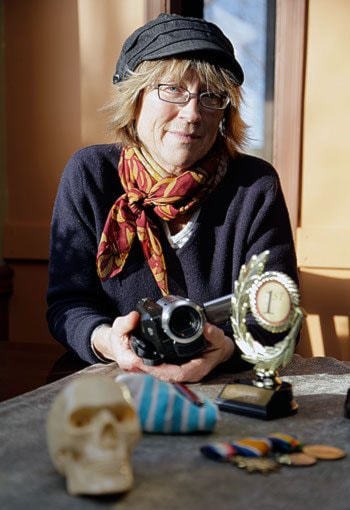The main character in Arlin McFarlane’s newest play tells the audience: “A coffee in the morning, a cigarette after sex, it is the habit of self that defines us.”
In life you need habits to function, McFarlane says. Something as simple as knowing how to walk is a habit.
“When we were one-year-old and learning how to walk our whole brain was busy figuring this problem out. It was figuring out crawling, it was figuring out standing, it was figuring out balancing,” she said.
“If we had to do that every day we wouldn’t be driving. So that all moved into habit.”
But those mundane activities are not the only types of habits explored in the play My Brain is Plastic.
After all, McFarlane says, habits can also be destructive. Things like addiction and self-harm are on the continuum of habit too.
My Brain is Plastic is a one-man show performed by Yukon’s Mary Sloan. It’s the story of a young girl who, after a traumatic experience in her childhood, copes by dissociating.
It’s a resourceful means of coping with the situation at first, until it becomes a habit.
“The thing about habits is they become subconscious. She doesn’t know she’s doing that. She’s just a kid,” McFarlane says.
“But now, all of a sudden there’s this habit of dissociation. So when she becomes an adolescent, it becomes really difficult to make connections with people.”
McFarlane’s story is as much about what is going on in the girl’s life, as it is about what’s going on in her brain.
The story is told by a neuroscientist who talks the audience through what happens in the brain when habits are formed and how they can be broken.
“This is a play that addresses troubling circumstances and looks at how we can reprogram our brain because it’s so incredibly plastic,” McFarlane says.
McFarlane worked with a UBC neuroscientist and a trauma therapist while writing the play to make sure she got the science right.
Now she’s bringing the play to Watson Lake in the hope that its themes will start a conversation there.
The play will be performed there twice over a week in November. The first show will be for the students at the community’s school.
A group of students will then be encouraged to make suggestions about how the play could speak more directly to their community, McFarlane says. They’ll get to work with the entire crew to make the show more personal.
Other students will work with Barb Hinton from the Heart of Riverdale community centre and Jona Barr of the Splintered Craft studio to create art based on what they’ve seen.
Then, at the end of the week, a community feast will showcase the art and a second showing of the updated play.
The floor will be opened for a community discussion after that, McFarlane says.
“I think that potentially we will engender a community conversation about addictions and self harming,” she says, “because many of our rural communities have self-harming behavior as a very difficult problem, and studies have shown that self-harming behavior is a very difficult addiction and a very compelling addiction.”
McFarlane says her idea has received support from the community, including from Dena Keh and the Liard Aboriginal Women’s Society.
Social work and counselling professionals are coming from outside Watson Lake to be part of the conversation.
Sometimes art makes it easier to talk about difficult topics, she says.
“Sometimes if you tell a story it allows you to have a conversation about difficult things that you might not be able to address directly.”
Contact Ashley Joannou at
ashleyj@yukon-news.com
